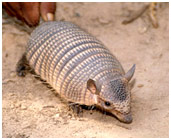Armadillo are small placental mammals, with bony armor shell. Given below are some amazing facts and interesting information about Armadillo.
Facts About Armadillo
Armadillos belong to the same family as anteaters and sloths. These animals are essentially insectivores and feast largely on arachnids and soft shell insects. Armadillos are small placental mammals, with a bony armor shell covering. There are around 20 species of the mammal that is recognized by the number of bands on its armor. Nearly all the species reside in North and South America, in varied environmental surroundings, with only one in the United States, namely the Nine Banded Armadillo. The natural habitat of these mammals is such because they cannot stand cold. Their metabolism is quite slow, as a result of which very low heat is produced in the body. However, they are versatile animals and are proficient in swimming and digging. The armor on their back is made up of plates of dermal bone, covered by overlapping scales called ‘scutes’. These act as the main protection from predators. For some more interesting facts and amazing information about Armadillo, read on.

-
The word ‘Armadillo’ means ‘little armored one’ in Spanish.
-
Armadillos are nocturnal, but have poor eyesight.
-
There are over 50 million Armadillos in the U.S. alone.
-
Armadillos have lower body temperature as compared to other mammals.
-
They are used as research animals for disease like Leprosy.
-
Armadillos can jump up in the air to a height of 3 ft., when they are scared.
-
Armadillos give birth to four identical young ones at a time. The four offspring develop from the same egg and even share the same placenta.
-
Armadillo is a very good swimmer and can float in water by trapping air in its intestines.
-
If disconnected or ripped apart, the Armadillos genitals still function and are active.
-
Armadillos conserve energy through a process known as ‘reta mirabila’. Through this process, they can regulate their blood flow and temperature much like marine animals.
-
Armadillos have a long sticky tongue to slurp up bugs and ants.
-
They have very sharp claws, with the help of which they dig burrows under the surface and even tear ant’s nest.
-
It is illegal to own an Armadillo as a pet in the state of Maine and in Hawaii.
-
Armadillos sleep for about 16 hours a day.
-
Armadillos can be housebroken.
-
Armadillos have a very low need for oxygen and can stop breathing for up to 6 minutes at a stretch.
-
The young Armadillos do not have the armor, but soft leathery skin instead, which hardens with time.
-
The back of a regular Armadillo are made of plates, which are made of ‘hard dermal bones’. These are covered with overlapping scales, which act as protection from predators.
-
When scared, threatened, or attacked, Armadillos curl up into bulls, presenting their armors from all sides.
-
Armadillos are also descendents of its prehistoric versions called ‘Glytodons’, which grew up to 9 ft. and weighed 2 tonnes.
-
Young Armadillos are called ‘pups’.
-
The collective name for a group of Armadillos is typically called an ‘arrangement’, a ‘pack’ or a ‘herd’.
-
In many parts of the world, Armadillo meat is considered a delicacy and was typically found in menus during the Great Depression of the 1920s. During this time, Armadillos were nicknamed ‘Hoover Hogs’ by the people who consumed them.
-
Some female Armadillos have the capacity to delay implantation of fertilized eggs in their bodies during times of stress and give birth to pups much later. This is commonly known as ‘Virgin Births’.


See also
More in 'Society'
More from iloveindia.com
- Home Remedies | Ayurveda | Vastu | Yoga | Feng Shui | Tattoos | Fitness | Garden | Nutrition | Parenting | Bikes | Cars | Baby Care | Indian Weddings | Festivals | Party ideas | Horoscope 2015 | Pets | Finance | Figures of Speech | Hotels in India : Delhi | Hyderabad | Chennai | Mumbai | Kolkata | Bangalore | Ahmedabad | Jaipur
- Contact Us Careers Disclaimer Privacy Policy Advertise With Us Lifestyle Sitemap Copyright iloveindia.com. All Rights Reserved.




